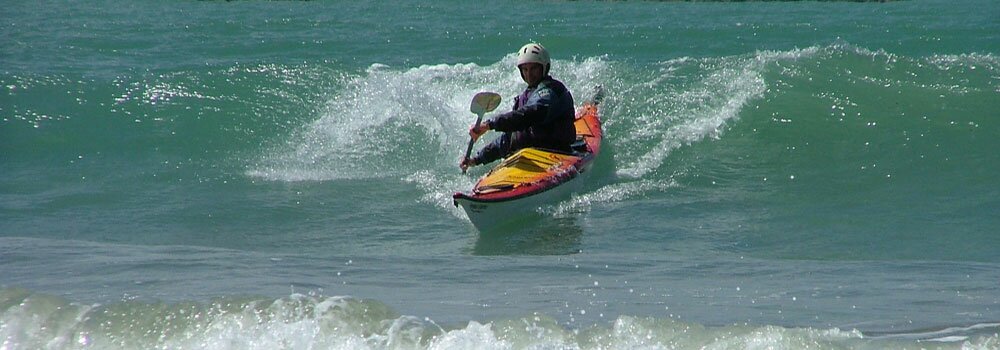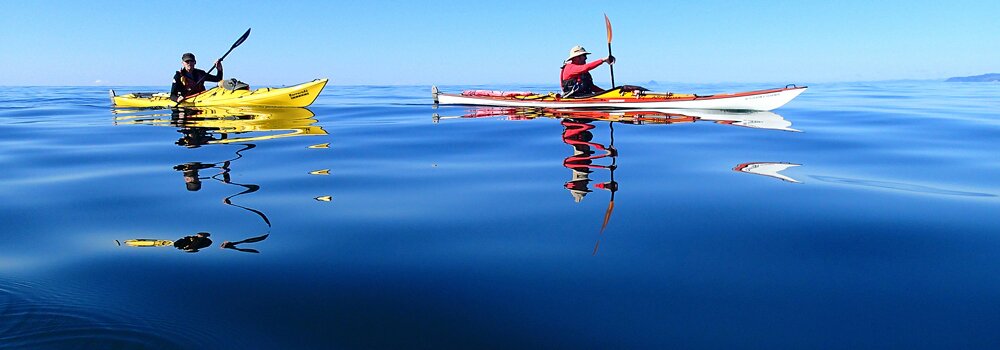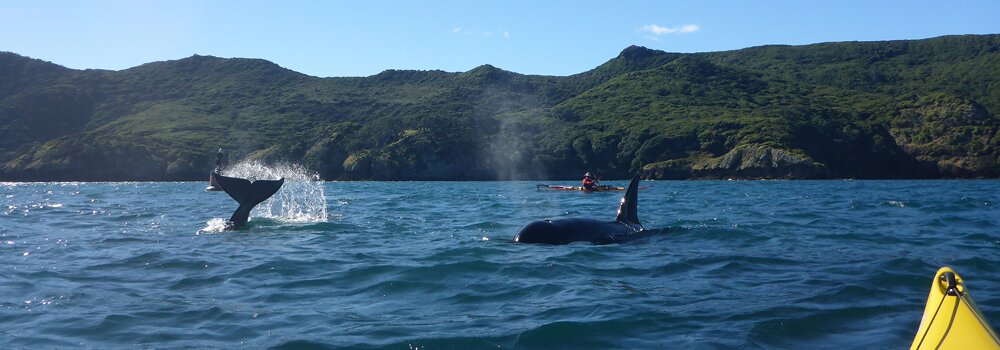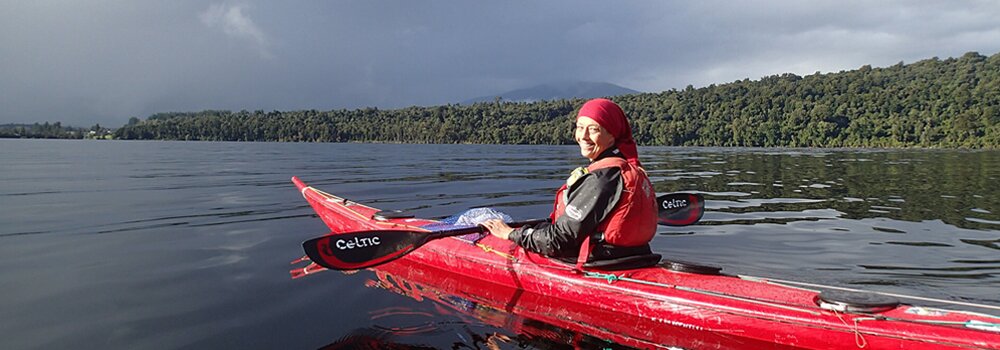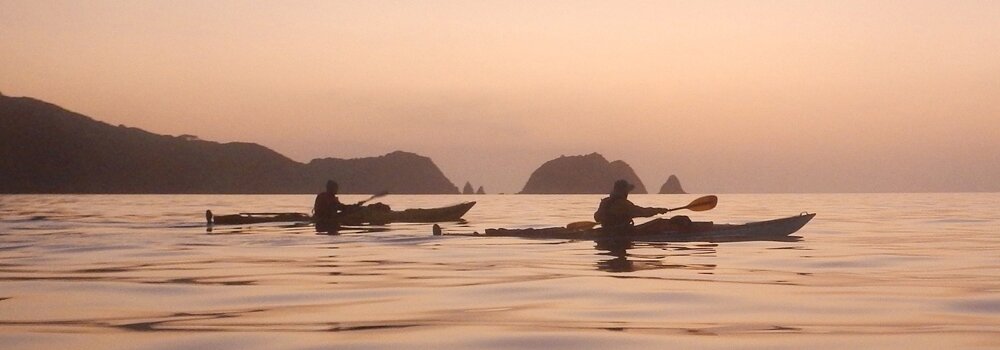Equipment
Index
(alphabetical listing)
Bits & Pieces by Sandy Winterton
Dry Suits – leak testing and repair
Greenland Paddle - Make Your Own
Loading and Transport of Kayaks
Paddle length - things to consider
Kayaks – types and materials
Here we are talking about sea kayaks. Though some sit-in have also been moulded as sit-on, most sit-on kayaks are beamy and used for short part day paddling or for fishing where some can rival a deep-sea trawler for the gear carried.
Paddle Length – things to consider
Paddles, paddle length and why Americans can’t paddle
Maybe the last bit of the title should be explained first. Some manufacturers recommend paddles of a length suitable for pole vaulting. We are sea kayaking aren’t we? A big strong paddler can get away with any style but for most of the rest of us efficiency means going further and enjoying it without stressing ourselves. The disadvantage is we have to sit around waiting for those without the strength or technique to catch up. Note, Werner, who used to be one of those with a too-long chart has changed its sizing recommendations and now tends towards something reasonable.
Bits & Pieces by Sandy Winterton
A Blog by Sandy Winterton, based in New Zealand. Random musing, photos and drivel on kayakkery, travel and general boatiness (Sandy’s own words). Some of the articles were first published in the ‘New Zealand Sea Canoeist’ magazine.
Sandy Winterton’s blog site
An investigation into how wind affects kayaking speed – Winds-of-change PDF
Lightweight rescue line. This lightweight rescue line is so small it lives in your PFD and you always have it with you. Lightweight-rescue-line PDF
Checklist
Equipment required for multi-day paddling with no support. The CHECKLIST by Peter Sullivan is a list of necessities, optional extras and downright luxuries in no order of priority. Use it as a basis to start your own checklist and use it. It’s not pleasant when you forget your teddy! (Not listed but I know someone whose teddy goes along on all his kayak trips!) The list is fairly generalised so check appropriate chapters of the KASK Handbook for more specific information, especially with your First Aid requirements
Kayak Transport and Loading
Not many kayakers have their kayak stored close to the water and not many are willing to use their bicycle, as an example, living in Christchurch and cycling to paddle out of Havelock. For the rest of us, we use a car or van. Loading the kayak on to the rack single handed can be awkward.
There are two ways, end on and sideways.
End-on loading – usually requires something more complicated though in some cases just a piece of carpet attached over the end of the vehicle is enough and the kayak is slid up and into the rack. The alternatives are a towbar mounted roller or V holder, a rear mounted roller or Hurlley rollers on the rear rack.
Some systems on the market include
The Australian K-Rack.
This Australian Strongarm system needs a towbar for mounting but it is easy.
The Rhino Rack T-Loader looks the same as above.
Yakima have their system.
Sideways loading – can be done by fitting a fold-out bar to the rear rack or a rod inserted into the rack. One end of the kayak is lifted on to the bar, the other end is lifted on to the rack, pulled down and the far end swung on to the rear rack. Simple.
For the frugal, this is basically the webmaster’s system and has been been used for years (cost nil). Note – being an Australia site the extension bar is fitted to the wrong rack bar as it works better for long sea kayaks if fitted to the rear bar.
The Wing Paddle and Developments
On the Wing PDF (390 KB) by Sandy Winterton. A description of the latest development of the Wing paddle and its slow morph to a filled in foil.
This article is from KASK’s Sea Canoeist Newsletter No.147.
It is interesting that the Wing appears to be getting closer in foil shape to the Aleut paddle, developed thousands of years ago. Note that the Aluet paddle has an asymmetrical foil and the Greenland paddle a symmetrical foil.
Now, if we take a wooden paddle and burn it, will we have a carbon fibre paddle?
Make Your Own Greenland Paddle
Making a West Greenland Paddle PDF (57 KB) ~ by Chuck Holst
Note that many consider that this is the “definitive” description if carving one out of a 100×50 (4″x2″). See the NZ method if you want to save trees and money.
Making a Greenland Paddle ~ by Matt Johnson. This is a 32 minute YouTube video by Matt Johnson.
Making a Greenland Paddle ~ by John Caldeira
Making a Carbon Fibre Greenland Paddle ~ by Duane Strosaker
Making a Greenland paddle NZ method (716 KB), a PDF of the method shown below and shows how to minimize wasteage. If you don’t want to read the PDF, the full article is here – Read the full article here…
GP vs Euro Paddles
A comment on names first.
Greenland paddle (GP) – is the light, narrow bladed, with a symmetrical foil shaped cross-section blade, unfeathered, “stick”, seen used by some grey bearded paddlers.
Euro – has short, flat or near flat blades, usually feathered, often heavy, paddle used by most other paddlers.
Wing – the paddle of choice for racing. It is also quite common amongst touring sea kayakers. It’s cross section is foil shaped like the wing of an aircraft though they are usually simply undercambered meaning open on the under side where an aircraft’s wing will be filled in on the under side.
Weights – generally paddles used by most paddlers run about 800 – 1000 grm. A GP can be anywhere from 700 – 1000 grm. If you use a carbon fibred version of either, then the weights will be less and the cost will be higher.
Dry Suits – leak testing and repair
A few NZ paddlers use drysuits. As with everything, these are prone to wear and the links describe methods of leak testing and repair.
Leak testing and repair of a drysuit.
Dublin University Drysuit Repairing
Drysuit Repair PDF
Flying With a Stove
Have you ever wanted to take your camping stove with you by air but were afraid that the latest attitude towards such things would make it impossible?
How to and the requirements of some of the airlines are given below
Towing Equipment & How to
The following links have useful information about towing –
Kayarchy Equipment has a bit on tow ropes and
Kayarchy Towing has the “how to” information about towing.
For further information including making a towline and tow point –
UKSK Towlines
Note that a central tow point is shown. This works well on a kayak without a rudder or a sticking up stern but if the tow point is to one side it is much easier to release and to keep the towline clear of the rudder. You could put an attachment point on both sides making it easier when a dual tow is used and it would not matter which side the towed kayak was on.
Making a light weight towline (PDF 630 KB) by Sandy Winterton.
